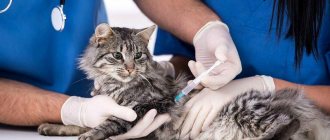Tell me, do you often, when you see a cat, feel the urge to stroke it or scratch it behind the ear? But, unfortunately, we forget that a cat is a predatory animal that can not only purr and caress, but also painfully scratch and bite. At the same time, bites and scratches can often take a long and painful time to heal, become inflamed and fester. And sometimes a cat can even be a carrier of infectious diseases, such as rabies, and then after a bite you will receive a course of preventive vaccinations.
Consequences of a cat bite
In general, a cat bite itself is very painful, because the cat’s teeth are small and very sharp. This structure of the teeth helps the cat tear the meat of prey with ease. And although the bite marks seem insignificant in appearance, in fact the wounds are quite deep, and therefore the infection can penetrate deep into the tissue. Also, do not forget that cat saliva contains a huge number of pathogenic microorganisms, which, when entering the bloodstream (and with it into the nerves, blood vessels, organs) can cause serious inflammation in humans, including an abscess. So, if you notice swelling and redness at the site of the bite, your temperature has risen, or ichor or blood is leaking from the wound, or your lymph nodes have become enlarged, you should consult a doctor immediately.
Most often, through a cat bite you can become infected with pasteurellosis, which can lead to the formation of phlegmon (cutaneous form), sluggish pneumonia (pulmonary form) and even purulent meningitis, endocarditis, brain abscess (septic form), etc. You can also become infected with leptospirosis through a bite, salmonellosis, streptococcosis and tetanus.
Particularly dangerous are cats suffering from rabies, an acute viral infectious disease that is equally dangerous for both animals and humans. The disease is very severe and without treatment inevitably leads to death. To avoid dangerous consequences to life and health, it is necessary to administer a rabies vaccine no later than 14 days from the moment of the bite. It is also worth remembering that a cat infected with rabies does not always look aggressive and rush at people.
– Normal cat behavior is very different from the behavior of a cat infected with rabies. This virus affects different parts of the animal's brain, and leads to completely unnatural behavior. This is not always aggression, it can be, on the contrary, timidity,” explains felinologist, member of the Felinological Federation of Bashkiria Sergei Zabolotny.
Allergy to cats
When will a vaccine against cat allergies be invented: doctors' opinion
Diagnosis of rabies
This diagnosis can be made when symptoms of the disease appear after an animal bite. Rabies is confirmed by examining a skin sample taken from the back of the head and isolating the virus from tear, cerebrospinal fluid, and saliva.
Laboratory tests required to diagnose rabies:
- general blood test (excluding ESR and leukocyte formula);
- general urine analysis;
- a blood test to determine antibodies to the rabies pathogen;
- Determination of the causative agent of rabies through examination of tissues and biological fluids of the body:
— examination of fragments of skin tissue on the back of the head, cornea imprints;
— study of the genetic material of the virus using PCR;
- examination of brain tissue using electron microscopy.
Other research methods used to diagnose rabies:
- EEG or electroencephalography is a method that allows you to evaluate the electrical potentials of the brain.
What to do after a cat bite
If you are bitten by a cat, the first thing you need to do is thoroughly wash the bite area with running water and soap (preferably laundry soap) to wash off the saliva and bacteria. You need to rinse for a long time - at least 15 - 20 minutes. If there is no water source nearby, at least use wet wipes.
Afterwards, you need to treat the wound with 3% hydrogen peroxide or chlorhexidine solution (as a last resort, alcohol), and then lubricate it with iodine, cover with a sterile cloth and bandage it.
– Next, you need to go to the hospital, where the doctor will examine the wound, assess its depth and decide how to carry out initial surgical treatment. If the wound is extensive and lacerated, a decision will be made to suturing it, but for infected wounds, suturing is rarely performed. Afterwards, the doctor will prescribe a course of vaccine and a tetanus shot, and then he will monitor your condition,” says traumatologist Vadim Fadeev.
Forms
There are three forms of rabies in animals:
- Violent form
We discussed the violent form of rabies in cats in detail in the section on symptoms and signs, since it is the most common form of rabies in cats, but there may be exceptions. The main difference between this form and the others is that the animal turns from a gentle domestic animal to wild and aggressive. This happens due to severe damage to the brain; we can say that the virus controls the animal and forces it to bite others, thus spreading through saliva.
- Silent form
With this form of flow, excitation is not expressed at all or is weakly expressed. Sometimes rabies in kittens can manifest itself in this way. Paralysis progresses quite quickly, swallowing becomes difficult, and profuse, foamy salivation is observed. The animal's gaze is expressionless, indifferent, directed as if into emptiness. There may be prolapse of the third eyelid, strabismus, and different pupil sizes. Death occurs even faster than with the violent form, on the 2-4th day.
- Atypical form
This form of flow is extremely rare. Refusal to eat, exhaustion of the animal, inflammatory processes in the gastrointestinal tract, and hemorrhagic diarrhea are noted. No aggression is observed. This form can last up to 3 months or longer.
How to treat a cat bite
Treatment for a cat bite may include vaccination against rabies, tetanus, administration of medicinal serums, surgical treatment of wounds, antibacterial therapy and other therapeutic measures.
If rabies is suspected, the COCAB vaccine or a vaccine plus a specific immunoglobulin is administered (depending on the location of the bite - if the cat has bitten the face, hands, neck, perineum, the spread of the virus occurs much faster). The emergency vaccination course in Russia consists of 6 doses, which are administered on the zero - third - seventh - 14th - 30th and 90th days.
At the same time, it is important to monitor the animal (if possible, of course): if after 10 days it is alive, it means that it does not suffer from rabies, and the vaccination course can be interrupted. If you can’t monitor your cat’s condition, you will have to complete the entire course.
As for the tetanus vaccination, it is given to both children (DTP) and adults (booster vaccination every 10 years), as well as for emergency indications for bites, injuries and cuts. If you missed revaccination, you cannot count on lasting immunity, which means you will need to be vaccinated against tetanus.
It is important to know
First aid: how to provide it in different situations
Treatment of rabies in humans
Unfortunately, if symptoms of this disease do appear, it most often leads to death. Treatment in most cases can only alleviate the patient's condition.
After a bite from a wild animal, the wound must be washed, carefully examined for the presence of any foreign bodies (for example, broken teeth) and surgically treated. After this, the patient is immediately injected with immunoglobulins - special cells of the immune system. The patient undergoes vaccination over the next two weeks (5 injections in total). The disease can only be prevented in this way.
If a pet is bitten, it should be observed for approximately 10 days and if symptoms of rabies are noticed, immediately consult a doctor so that he can take measures to immunize the bitten person. A sick animal that has become a source of rabies must be isolated.
Treatment of rabies can also alleviate its symptoms - reduce pain, relieve seizures. For this, appropriate medications are used, and the patient is placed in a special ward.
Popular questions and answers
How to avoid a cat bite?
– If you see an adorable stray kitten on the street, you shouldn’t pet it immediately. And in general, you shouldn’t touch a cat (no matter whether it’s your friend’s cat or a stray) if it’s not your pet. You never know what to expect from an animal. So, the first piece of advice is to stay away from other people's animals. To prevent your own cat from inadvertently biting you, try to prevent the animal from feeling afraid. Bathing, a trip somewhere out of town in a carrier, a trip to the veterinarian, exhibitions - this can cause stress in the animal, so it is worth accustoming it in advance to avoid scratches and bites, explains felinologist Sergei Zabolotny.
Why do cats bite?
– Cats bite in two situations: during play (which is unacceptable, this is a lack of education), or in a stressful situation, when they are in pain or very scared. For example, even the most good-natured cat can severely bite its beloved owner during some painful veterinary procedure. Cats can also bite when stressed, when they are taken out from somewhere, taken outside, where there is a lot of extraneous noise, and restrained by force. This reaction is normal, it can be predicted and controlled. Therefore, cats are accustomed to exhibitions and trips, for example, gradually, as well as to the bathing procedure. Options when an adult animal attacks its owner or house guests are either early weaning from its mother (the kitten was taken before 2 - 2.5 months and its socialization is impaired). Or a sign of illness, most often severe pain, for example with oncology,” explains felinologist Sergei Zabolotny.
Which cat breeds attack more often?
– I would not say that any particular breed is more prone to aggression than others. This is rather a disadvantage of raising a particular cat. It’s just that some will express their dissatisfaction loudly and for a long time (Bengal cats, for example), and some will silently endure everything. But under extreme stress, absolutely any cat can bite. Although under normal home conditions they do not experience such stress, the felinologist emphasizes.
Do I need to get a rabies vaccine after a cat bite?
“Vaccination against rabies after a cat bite is mandatory, because rabies is a deadly disease, and today there are no drugs for its treatment,” explains traumatologist Vadim Fadeev.
What signs of rabies can a person have after being bitten by a cat?
– The incubation period for rabies is quite long, up to one year, so a person may not even suspect that he is infected for a long time.
At the first stage, the infected person may notice redness at the site of the bite, swelling and burning. Mood changes appear - anxiety, apathy. The patient complains of headaches and depression. The temperature may rise slightly. At the next stage (stage of hyperarousal), the patient exhibits increased agitation, aggression, fear of water, bright light and loud sounds. Convulsions, breathing problems, and laryngeal spasms may occur. The patient complains of severe salivation, weight loss, dehydration and metabolic disorders are noted. At the last stage, the stage of paralysis, mental disorders subside, hyperexcitation is replaced by immobilization, paralysis of cardiac and respiratory activity occurs - and, as a consequence, the death of the patient. That is why it is important to get vaccinated against rabies in a timely manner after being bitten by an infected animal, explains traumatologist Vadim Fadeev.
Routes of transmission
The natural reservoir of rabies is wild animals (foxes, wolves, wild boars, badgers). But in humans, symptoms of the disease most often appear from a cat or dog bite.
The virus begins to be excreted in the saliva of an infected cat 3-10 days before clinical signs appear. This continues throughout the entire period of the disease, until the death of the animal. Therefore, a person is at risk of contracting rabies not only through a bite, but also through contact with fur that has been exposed to the saliva of an infected cat.
Very important! The rabies virus persists in the animal's corpse for several weeks after death. Therefore, it is necessary to completely eliminate contact with the cat’s body, surrounding objects and surfaces, after which you should call the veterinary service or the Ministry of Emergency Situations.
In medical practice, isolated cases of human infection from bat bites have been recorded. But those most at risk are hunters who come into contact with killed wild animals, do not follow safety precautions, and do not send them to a veterinary laboratory for examination. They can also be bitten by a wounded animal.
In small rodents, a protracted latent phase of rabies or virus carriage is often observed. At the same time, cats can become infected from them during hunting. But cases of human infection from rats and mice are extremely rare.











